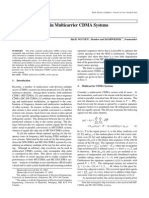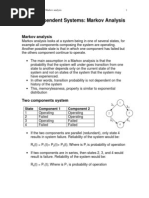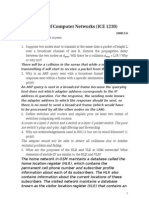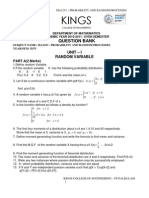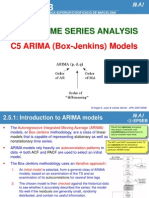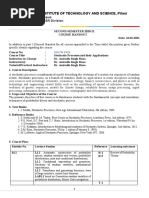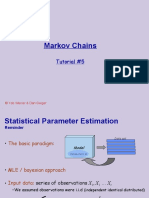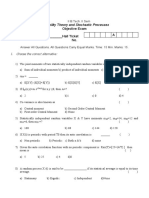Poisson Processes, Markov Chains and M/M/1 Queues: Advanced Communication Networks
Poisson Processes, Markov Chains and M/M/1 Queues: Advanced Communication Networks
Uploaded by
Ashish KumarCopyright:
Available Formats
Poisson Processes, Markov Chains and M/M/1 Queues: Advanced Communication Networks
Poisson Processes, Markov Chains and M/M/1 Queues: Advanced Communication Networks
Uploaded by
Ashish KumarOriginal Description:
Original Title
Copyright
Available Formats
Share this document
Did you find this document useful?
Is this content inappropriate?
Copyright:
Available Formats
Poisson Processes, Markov Chains and M/M/1 Queues: Advanced Communication Networks
Poisson Processes, Markov Chains and M/M/1 Queues: Advanced Communication Networks
Uploaded by
Ashish KumarCopyright:
Available Formats
Review
Examples
M/M/m
Poisson processes, Markov chains and M/M/1 queues
Advanced Communication Networks
Lecture 5
Review
Examples
M/M/m
M/M/1 Analysis
Poisson Arrivals, Exponential service times, 1 server (FIFO)
Look at discrete times With high prob., only one arrival or departure Discrete-time Markov chain
1 0 1 2 3 1 1 1
Review
Examples
M/M/m
Analysis Contd..
Steady state prob.s {pn } Balance equations pn = pn1 pn = pn1 =
n
p0 = n p0
pn = 1 p0 = 1
n
pn = (1 )n
Stability of system: <
Review
Examples
M/M/m
Computing system averages
Comment: pn = f ( ) As 0 same answers for cont. time model Average number in system
N=
n =0
npn =
n =0
nn (1 )
= = 1 Average system delay: Littles law T = As 1, N , T N 1 =
Review
Examples
M/M/m
100 90 80 70 60
50 40 30 20 10 0 0 0.2 0.4 0.6 0.8 1
Single pole response - typical of queuing systems Other system variables W =T
1
NQ = W =
2 1
Review
Examples
M/M/m
Compare to D/D/1 queue
one arrival every
NQ
sec, 1 departure every
D/D/1
sec
=1
NQ = 0 < 1. M/M/1: queue size, delay blows up for near 1 Intuition: Variability causes performance loss
Review
Examples
M/M/m
Changing transmission rate
M/M/1 queue: Arrival rate and Service time is doubled What happens to delay? N?
2, 2 stays same N= N stays same 1 T = 1 = 1
1
T reduces by
1 2
Review
Examples
M/M/m
T old
T new
Review
Examples
M/M/m
Example 2
Statistical Multiplexing
/M
TDM
/M
/M
/M
/M
/M
M independent Poisson streams, rate TSM = 1
TTDM =
Delay reduced by factor of m Statistical Multiplexing gain
Cons: Difcult to isolate Bad ows ; Provide guarantees
Review
Examples
M/M/m
Distribution of System Variables
What about distribution for N? For eg: Variance
Var (N ) =
n =0
n (1 ) n2 (1 )2
Likewise, Distn. for T in Prob. 3.1 (M/M/1 queues)
Review
Examples
M/M/m
PASTA property
Interested in state of system just before packet arrives Eg: to calculate Blocking probability Steady-state prob. arriving packet sees in the system
t
lim Pr( N (t ) = n| arrival @t + ) ?
Isnt this same as pn ? Not necessary Eg: D/D/1 system, < Above prob. is zero, but no steady-state exists
Review
Examples
M/M/m
PASTA property Contd..
For Poisson trafc,
The two quantities are equal PASTA Proof an = P{ N (t ) = n| arrival @t + } = P{ N (t ) = n| A(t , t + )} P ( A(t , t + )| N (t ) = n) P (N (t ) = n) (t )=n,A(t ,t + )) = P( N P = (A(t ,t + )) P (A(t , t + ))
But A(t , t + ) ind. of N (t ) = n an (t ) = P (N (t ) = n) Holds for broad class of queuing systems w/ Poisson arrivals, ind service distribution (Memoryless property)
Review
Examples
M/M/m
M/M/1 - Last slide
What is the prob arriving customer nds system empty? p0 = 1
Review
Examples
M/M/m
Other Markovian systems: M/M/m
0 1 2 2 3 3 m m+1
m servers in system
Given 2 packets in service, Prob of departure = Prob(1st packet departs) + Prob(2nd packet departs)
= + Service time of state n = m n > m
Ex: Circuit switched networks, blocked calls wait
Review
Examples
M/M/m
M/M/m analysis
Balance equations
pn1 ( ) = pn (n ) n = 1, 2, , m pn1 ( ) = pn (m ) n > m pn = pn = n (n 1) m
n m
p0
m
nm n>m
1 m!
p0
Review
Examples
M/M/m
M/M/m analysis Contd..
pn =
If stable: pn = 1 Stability condition: =
n =0
1 n n! (m) p0 m m n m!
nm n > m,
<1
m 1
p0 =
n =0
(m)n (m)m + n! m!(1 )
Review
Examples
M/M/m
Erlang C formula
What is the prob arriving packet has to wait for service? Same as prob that servers are busy (Follows from PASTA property)
PQ = Pr(Queuing) = Pr(N m)
=
n =m
pn = p0
(m)m m!(1 )
Widely used in telephony Model for Blocked delay calls Formula also hold for M/G/1 systems (Invariance property)
You might also like
- Stochastic Modelling 2000-2004Document189 pagesStochastic Modelling 2000-2004Brian KufahakutizwiNo ratings yet
- Tenta 210826Document3 pagesTenta 210826InetheroNo ratings yet
- QueueingDocument50 pagesQueueingJagan RajendiranNo ratings yet
- Principles of Communications Lecture 7: Analog Modulation TechniquesDocument31 pagesPrinciples of Communications Lecture 7: Analog Modulation TechniquescyderNo ratings yet
- MmcinfinityDocument17 pagesMmcinfinityKartik GuptaNo ratings yet
- DSP Unit 5Document13 pagesDSP Unit 5Charles ThomasNo ratings yet
- Queueing TheoryDocument8 pagesQueueing TheorysamqmulNo ratings yet
- Dimensional Analysis PDFDocument34 pagesDimensional Analysis PDFadrianrrccNo ratings yet
- Systems Methodology and Design IIDocument22 pagesSystems Methodology and Design IIYorghos MenikidisNo ratings yet
- Nyquist Sampling, Pulse-Amplitude Modulation, and Time-Division MultiplexingDocument10 pagesNyquist Sampling, Pulse-Amplitude Modulation, and Time-Division MultiplexingIbra NazlaNo ratings yet
- ADC Unit 4 Part 1- FinalDocument95 pagesADC Unit 4 Part 1- Finalvenkat2022420No ratings yet
- Queueing Theory: Frank Y. S. LinDocument50 pagesQueueing Theory: Frank Y. S. LinsuhasNo ratings yet
- Time Response of Second Order Systems - GATE Study Material in PDFDocument5 pagesTime Response of Second Order Systems - GATE Study Material in PDFAtul ChoudharyNo ratings yet
- SM 38Document21 pagesSM 38ayushNo ratings yet
- Ieee CSL2021Document6 pagesIeee CSL2021Adriano Nogueira DrumondNo ratings yet
- Project Report: Queuing of Network PacketsDocument13 pagesProject Report: Queuing of Network Packetsrocks271089No ratings yet
- M/M/1 and M/M/M Queueing Systems: 1. Preliminaries 1.1 Kendall's Notation: G/G/N/K QueueDocument12 pagesM/M/1 and M/M/M Queueing Systems: 1. Preliminaries 1.1 Kendall's Notation: G/G/N/K QueueBinesh JoseNo ratings yet
- Lec8 MPIalgorithmDesignDocument12 pagesLec8 MPIalgorithmDesignAnirudh SethNo ratings yet
- BB 06 SpreadSpectrum PDFDocument59 pagesBB 06 SpreadSpectrum PDFjmNo ratings yet
- Littles LawDocument22 pagesLittles LawupamaharikrishnanNo ratings yet
- Chapter 6Document21 pagesChapter 6Shida ShidotNo ratings yet
- A Fast Wavelet Transform-Domain LMS AlgorithmDocument4 pagesA Fast Wavelet Transform-Domain LMS AlgorithmAzka PamungkasNo ratings yet
- Signal Processing and DiagnosticsDocument191 pagesSignal Processing and DiagnosticsChu Duc HieuNo ratings yet
- ReviewCh9 M M 1 QueueDocument24 pagesReviewCh9 M M 1 QueueBomezzZ EnterprisesNo ratings yet
- Safety System Availability: 1oo2d and TMRDocument9 pagesSafety System Availability: 1oo2d and TMRGlaucio SoaresNo ratings yet
- Digital Signal Processing Lecture-2 29 July, 2008, TuesdayDocument51 pagesDigital Signal Processing Lecture-2 29 July, 2008, Tuesdaysamina taneNo ratings yet
- Lecture 24: Queuing Models: ! ! ! ! ! ! " " " " " " # QueueDocument4 pagesLecture 24: Queuing Models: ! ! ! ! ! ! " " " " " " # QueuespitzersglareNo ratings yet
- Impulse Response Measurements Using MLS: Jens HeeDocument16 pagesImpulse Response Measurements Using MLS: Jens HeeGracia Adarrini Oktv ParokeNo ratings yet
- ENCS 6161 - ch12Document13 pagesENCS 6161 - ch12Dania AlashariNo ratings yet
- Design of Adaptive Equalizer: Using LMS AlgorithmDocument8 pagesDesign of Adaptive Equalizer: Using LMS Algorithmsoumya0324416No ratings yet
- Lecture 5Document79 pagesLecture 5Nishantha HewavithanaNo ratings yet
- Hydraulic Similitude and Mode LanalysisDocument78 pagesHydraulic Similitude and Mode LanalysisEng-Mohamed Hashi100% (1)
- L16 Little'StheoremDocument11 pagesL16 Little'StheoremRaj KumarNo ratings yet
- 2report Waiting LinesDocument36 pages2report Waiting LinesM.K. TongNo ratings yet
- Analysis of BER and Capacity For Dual-Hop OFDM Relay System With Subcarrier Mapping in Nakagami-M FadingDocument17 pagesAnalysis of BER and Capacity For Dual-Hop OFDM Relay System With Subcarrier Mapping in Nakagami-M FadingrzalshNo ratings yet
- Multirate DSP Part 1 (Read-Only)Document38 pagesMultirate DSP Part 1 (Read-Only)stephanNo ratings yet
- Test 1 Review: Chapter 2: Fourier Representation of Signals and SystemsDocument22 pagesTest 1 Review: Chapter 2: Fourier Representation of Signals and SystemsMahesh Kumar NigamNo ratings yet
- Lec13 - MMs - Queueing System 1-4 y 13-FinalDocument27 pagesLec13 - MMs - Queueing System 1-4 y 13-FinalJandresNo ratings yet
- FOPDT Model CharacterizationDocument6 pagesFOPDT Model CharacterizationHugo EGNo ratings yet
- Reliability Lecture NotesDocument12 pagesReliability Lecture Notespeach5No ratings yet
- Experiment No: 3 Design and Evaluation of Second Order SystemDocument6 pagesExperiment No: 3 Design and Evaluation of Second Order SystemBorse RajNo ratings yet
- On Carrier Spacing in Multicarrier CDMA Systems: LetterDocument4 pagesOn Carrier Spacing in Multicarrier CDMA Systems: Letterjavier_ivan91No ratings yet
- Chapter Two Sampling and Reconstruction: Lecture #5Document26 pagesChapter Two Sampling and Reconstruction: Lecture #5yohannes woldemichaelNo ratings yet
- 2 Marks Questions & Answers: Cs-73 Digital Signal Processing Iv Year / Vii Semester CseDocument18 pages2 Marks Questions & Answers: Cs-73 Digital Signal Processing Iv Year / Vii Semester CseprawinpsgNo ratings yet
- Link Delay: - Processing Delay - Queuing Delay - Transmission Delay - Propagation DelayDocument53 pagesLink Delay: - Processing Delay - Queuing Delay - Transmission Delay - Propagation DelayKetki SawantNo ratings yet
- Digital Transmission Pulse ModulationDocument33 pagesDigital Transmission Pulse ModulationLucky HimawanNo ratings yet
- Queueing Systems: Lecture 2Document7 pagesQueueing Systems: Lecture 2ArunsinghNo ratings yet
- Queueing TheoryDocument61 pagesQueueing Theory李冠霆No ratings yet
- Kinds of Queuing SystemsDocument4 pagesKinds of Queuing SystemsAmbuj VarshneyNo ratings yet
- Ci It TH Circuit Theory: Electronic & Communication Engineering Danang University of TechnologyDocument43 pagesCi It TH Circuit Theory: Electronic & Communication Engineering Danang University of TechnologyDoan Thanh ThienNo ratings yet
- LEC6 parallelAlg-BroadcastingDocument15 pagesLEC6 parallelAlg-BroadcastingSAINo ratings yet
- R P ECT PaperDocument15 pagesR P ECT Papermissile1124No ratings yet
- Markov AnalysisDocument10 pagesMarkov AnalysisValentin OlteanuNo ratings yet
- MatlabDocument38 pagesMatlabjuan salas100% (1)
- Differential Pulse Code Modulation and Delta ModulationDocument7 pagesDifferential Pulse Code Modulation and Delta ModulationdkishoreNo ratings yet
- Unit-Step Response:: 1 First Order SystemsDocument2 pagesUnit-Step Response:: 1 First Order SystemsNatalie ChehraziNo ratings yet
- Queuing Measure of PerformanceDocument16 pagesQueuing Measure of PerformanceKang LeeNo ratings yet
- Queuing Theory and Traffic Analysis CS 552 Richard Martin Rutgers UniversityDocument149 pagesQueuing Theory and Traffic Analysis CS 552 Richard Martin Rutgers UniversitySenthil SoundarajanNo ratings yet
- Bandpass DemodDocument27 pagesBandpass Demodseri126No ratings yet
- Green's Function Estimates for Lattice Schrödinger Operators and ApplicationsFrom EverandGreen's Function Estimates for Lattice Schrödinger Operators and ApplicationsNo ratings yet
- Fundamentals of Electronics 3: Discrete-time Signals and Systems, and Quantized Level SystemsFrom EverandFundamentals of Electronics 3: Discrete-time Signals and Systems, and Quantized Level SystemsNo ratings yet
- Analytical Modeling of Wireless Communication SystemsFrom EverandAnalytical Modeling of Wireless Communication SystemsNo ratings yet
- Exam 3 of Computer Networks (ICE 1230) : Answer in English and Total 16 PointsDocument2 pagesExam 3 of Computer Networks (ICE 1230) : Answer in English and Total 16 PointsAshish KumarNo ratings yet
- VHDL Lab FileDocument25 pagesVHDL Lab FileAshish KumarNo ratings yet
- File VHDL RtsDocument18 pagesFile VHDL RtsAshish KumarNo ratings yet
- aircom-ASSET7 0Document2 pagesaircom-ASSET7 0Ashish KumarNo ratings yet
- WWW - Syng: Create by ARIJIT DEDocument1 pageWWW - Syng: Create by ARIJIT DEAshish KumarNo ratings yet
- DBM Volts Watts DBM Volts Watts: Ele250 Signal Power LevelsDocument2 pagesDBM Volts Watts DBM Volts Watts: Ele250 Signal Power LevelsAshish KumarNo ratings yet
- Lecture 2: Markov Decision Processes: David SilverDocument57 pagesLecture 2: Markov Decision Processes: David SilverCường MậmNo ratings yet
- Probability & Random Process QBDocument13 pagesProbability & Random Process QBwizardvenkatNo ratings yet
- The Heston Model: Hui Gong, UCLDocument12 pagesThe Heston Model: Hui Gong, UCLharish dassNo ratings yet
- SRM Institute of Science and Technology Department of Mathematics 18MAB204T-Probability and Queueing Theory Module - IV Tutorial Sheet - I1 QuestionsDocument2 pagesSRM Institute of Science and Technology Department of Mathematics 18MAB204T-Probability and Queueing Theory Module - IV Tutorial Sheet - I1 QuestionsVasu GoelNo ratings yet
- TSCS Week5 TrendsDocument19 pagesTSCS Week5 TrendsAsimNo ratings yet
- Time Series Analysis: C5 ARIMA (Box-Jenkins) ModelsDocument14 pagesTime Series Analysis: C5 ARIMA (Box-Jenkins) ModelsStella Ngoleka IssatNo ratings yet
- Ec2 5Document26 pagesEc2 5S StanevNo ratings yet
- Box-Jenkins (Part 1)Document35 pagesBox-Jenkins (Part 1)Aiman NawawiNo ratings yet
- Birla Institute of Technology and Science, Pilani: Pilani Campus AUGS/ AGSR DivisionDocument3 pagesBirla Institute of Technology and Science, Pilani: Pilani Campus AUGS/ AGSR DivisionNOAH GEORGENo ratings yet
- Tutorial 05Document16 pagesTutorial 05eragornNo ratings yet
- Chapter 3Document48 pagesChapter 3RenithaTalariNo ratings yet
- Vinay AhlawatDocument5 pagesVinay AhlawatSulistyo HadiNo ratings yet
- Applied Probability in Operations Research PDFDocument68 pagesApplied Probability in Operations Research PDFanishgirmeNo ratings yet
- STAT 6100 - MATH 6180 Lecture 18 - Mean Time Spent in Transient StatesDocument7 pagesSTAT 6100 - MATH 6180 Lecture 18 - Mean Time Spent in Transient StatesRamana NimaiNo ratings yet
- MCQ Set2 PTSPDocument2 pagesMCQ Set2 PTSPPrabhakara RaoNo ratings yet
- Tutorial 1-Queueing TutorialDocument16 pagesTutorial 1-Queueing TutorialAyush KishoreNo ratings yet
- ArmaDocument32 pagesArmaraniinda6No ratings yet
- Whitt Ward - Stochastic Process LimitsDocument617 pagesWhitt Ward - Stochastic Process LimitsBranko NikolicNo ratings yet
- Notes On Stochastic Processes: 1 Learning OutcomesDocument26 pagesNotes On Stochastic Processes: 1 Learning OutcomesSheikh Mijanur RahamanNo ratings yet
- A Brief Introduction To Stochastic Calculus: 1 Martingales, Brownian Motion and Quadratic VariationDocument7 pagesA Brief Introduction To Stochastic Calculus: 1 Martingales, Brownian Motion and Quadratic VariationyygorakindyyNo ratings yet
- The M/M/1 Queue Is Bernoulli: Michael Keane and Neil O'ConnellDocument6 pagesThe M/M/1 Queue Is Bernoulli: Michael Keane and Neil O'Connellsai420No ratings yet
- Queueing TheoryDocument61 pagesQueueing Theory李冠霆No ratings yet
- Stochastic Processes - Report On Course ContentsDocument27 pagesStochastic Processes - Report On Course ContentsAkash ChhabriaNo ratings yet
- Teoria de Las DesicionesDocument23 pagesTeoria de Las DesicionesAndres ManosalvaNo ratings yet
- Chapter 7Document29 pagesChapter 7Vito LiuNo ratings yet
- Stochastic Calculus - An Introduction With Applications PDFDocument246 pagesStochastic Calculus - An Introduction With Applications PDFPatrickNo ratings yet
- Chapter-7: Stochastic ProcessDocument11 pagesChapter-7: Stochastic ProcessMd. Tanvir AhmedNo ratings yet
- Ornstein Isomorphism TheoremDocument2 pagesOrnstein Isomorphism Theoremdanny222No ratings yet









































